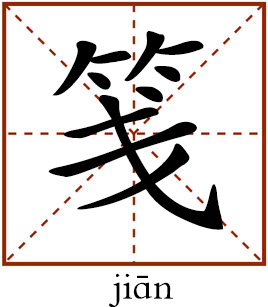Color prints

This character often refers to letter paper, especially artistic paper with designs. It originally referred to small, narrow pieces of bamboo used as writing material before paper was invented.
片笺片玉
piàn jiān piàn yù
Pian refers to one piece. Jian, which usually means letter paper, represents a piece of writing in this proverb. Yu refers to jade. The proverb literally means that a piece of writing is a piece of jade. Since jade is considered beautiful and valuable in Chinese culture, comparing writing to jade is a compliment to the writing, praising it for its beautiful, thought-provoking or emotionally inspiring language.
Although this proverb usually describes the quality of writing, there are some works that are deserving of its literal meaning. In other words, some collections of jian paper are as valuable as jade. For instance, Beiping Jianpu, or Chinese Color Prints of Today, is a collection of jian paper that was completed by two famous Chinese writers, Lu Xun (1881–1936) and Zheng Zhenduo (1898–1958) during the 1930s. Both writers shared a common interest in using and collecting jian paper. In 1932, Lu came back to Beijing to visit his mother. He was depressed by the realization that traditional Chinese writing tools, like the brush, were fading away from daily life due to the growing popularity of western pens. Affected by the decline of the brush, the use of jian paper, which was ideal for conveying the artistic expression of both Chinese calligraphy and painting, began to decline.
Lu wrote to Zheng to express his worries about the future of jian paper. He proposed collecting good jian paper and arranging it into a book, so as to contribute to preserving this cultural heritage. The desire to save jian paper and preserve its essence for later generations brought Lu and Zheng together. It took them several years to complete this book. The Beiping Jianpu contains about 400 pieces of jian paper, representing the best of jian paper in Beijing during the period of the Republic of China. It is regarded as a rich and varied blend of traditional Chinese culture with local influences. Thanks to the efforts of Lu Xun and Zheng Zhenduo, people still have a chance to see and feel the elegance of the Chinese literati of the old times.
edited by REN GUANHONG
